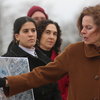3 3M budget gap looms Three dozen turn out to help GCSD make ldquo big decisions rdquo
GUILDERLAND Following through on a promise she made a year ago, her first time through the Guilderland budget process, Superintendent Marie Wiles has studied both the district’s use of time and its leadership structure and made recommendations for change in preparation for the new budget cycle.
On Tuesday night, about three dozen people, mostly parents of Guilderland students or teachers, turned out for the district’s second “Community Conversation” this school year to comment on those recommendations, among other issues.
The turn-out was far less than last year, the first time the “Community Conversation” format had been used instead of the former long-time Citizens’ Budget Advisory Committee, during which volunteers listened to presentations on the entire budget in a series of televised sessions and then gave their comments.
Last January, about 130 people, mostly parents and teachers, came to the first concept-based budget forum. A second forum last February drew about 250 faculty and staff members during the day, and about 180 people in the evening.
The school board’s president, Colleen O’Connell, helped shape the new process, in which the general public is invited to discuss selected budget-related issues, in small groups followed by a reporting out by the groups’ facilitators.
Asked why this year’s turnout was so much lower than last year, O’Connell told The Enterprise, “I don’t know. We still have big decisions to make.”
She went on, “At this time last year, we were only looking at a $2 million gap.”
In the past two years, faced with declining aid and increased pension and health-care costs, the district has cut about 100 jobs. The current budget is about $89 million.
With a rollover budget, keeping programs and staff the same for next year, Guilderland is looking at a $3.3 million revenue shortfall. Under new state legislation, if the budget were to be voted down twice, a contingent budget would have to be adopted, which would require $4.9 million in reductions.
“The stakes got higher,” said Assistant Superintendent for Business Neil Sanders, explaining that, with a contingency plan, the tax-levy increase would have to be zero.
Wiles said after Tuesday’s session that she wished more people had come. “I suspect it’s because we don’t have solid numbers,” she said. The third “Community Conversation” is scheduled for Feb. 7 when more figures, such as those for Guilderland’s state aid, based on the governor’s budget, presented Tuesday, will be available, she said.
Wiles said she would be interested to hear what students have to say in a Jan. 31 session. “They are living with the results of our decisions,” she said.
Asked if she learned anything new at Tuesday’s sessions, Wiles said, “We were curious about the last question.” Guilderland voters haven’t approved the district’s budget by a vote of more than 60 percent since 2008, before the start of the recession. With the new state-imposed tax-levy limit, a vote of 60 percent or more is needed to go over the roughly 2-percent cap.
“There is no number that’s too much,” Sanders said on Tuesday night. “The question is, can you get enough votes.”
Several of the Suburban Council school districts including Niskayuna, North Colonie, and Bethlehem have passed their budgets in recent years with more than 60 percent of the vote.
Participants at Tuesday’s forum were asked, “Why do you think the district has not reached that voter approval threshold?”
Answers included: low voter turnout about 3,500 in a district with roughly 10 times that many residents; salaries that are too high; the district is not as wealthy as it is perceived to be; people not voting because of a lack of communication; and people assuming the budget will pass so they don’t come out to vote.
Varied views on budgeting, schedules, and technology
Participants were also asked to comment on whether the community would accept “data-driven” budgeting as opposed to “emotional thinking.” Wiles described data-driven budgeting as “a flip” on what Guilderland has done in the past and unlike what most school districts do, which is to start building from the previous year’s budget.
She described the data-driven process as asking what students need, and building from there. “There is no expectation that the needs of every student in every building is identical,” said Wiles.
Lori Rafferty, a high school health teacher and also a parent, said during the small-group discussions that a data-driven process is important because, traditionally in Guilderland, “If a group is vocal coming to board meetings to talk or writing letters even if it benefits only a small minority, you’ll get it.”
But then, she also spoke as a parent, saying of her son, “He’s the kind of student that, when you look at the data, he gets lost.”
“I hope they take more than one year worth of data,” said Ric Klug, whose son graduated from Guilderland; he is now a student at Clarkson University.
“And project what’s coming,” chimed in Dolores Weaver, a Guilderland parent who is also a teacher.
Forum participants were also asked if the community would support changes in the use of time in school schedules and changes in the administrative structure. Wiles has recently made televised reports to the school board on recommended changes in these areas. (Read the full stories online at www.AltamontEnterprise.com under Guilderland archives for Dec. 15, 2011 and Jan. 12, 2012.)
Some forum participants commented on detrimental changes that have already been made, such as increasing class sizes while cutting back on teachers’ aids.
“With larger class sizes and fewer support staff, the needs of kids can be monumental,” said Wendy McDowell-Smith, a teacher. “There used to be more focus on prevention. Now, there’s more crisis work.”
“The status quo is not sustainable, given the resources available,” Wiles told the crowd on Tuesday. She also said, “To preserve the shape, we would have to starve the substance.” Wiles acknowledged that challenging the status quo “is uncomfortable work.”
One group on Tuesday had a lively discussion on the pros and cons of the more flexible high-school schedule, which would replace the advisory period with study halls during which students could get help at learning centers.
Responding to a district assertion that 85 percent of students use the advisory period to do homework, Dolores Weaver said, “My child doesn’t use advisory for homework…She’s constantly getting extra help. She’s pulling 90s.” A teacher herself, Weaver said that often teachers have meetings and other obligations after school and can’t always help students then.
“The kids that go to study lab are the kids that are bright,” said Janelle Fletcher.
“My daughter is like, ‘I can take another class,’” said Ruth Ann Burby, speaking in favor of the proposed high school schedule.
Lori Rafferty, a member of the high school cabinet, said the proposed new schedule is “a financial decision because…advisory is so inflexible.”
“There’s time we’re in the hallway,” Rafferty said of having to teach classes in unusual places because of the current lack of flexibility in high school scheduling.
She concluded of the proposed schedule, “It’s not really ideal, but who’s happy about having to cut $4 million?”
Finally, the forum attendees were asked if the community could support technology investments; unlike the changes in scheduling and leadership, this would increase costs to create opportunities for students to access “the world beyond our walls,” said Wiles.
“Technology is a tool,” said Jeff Gregory, a computer technician at the high school, to his discussion group. “In my opinion, it should never replace a teacher.”
“What are the technology skills we want our students to have?” asked Lori Rafferty. “Ten years ago, we wanted them to put together a PowerPoint. Now, that’s kind of obsolete.”
She also said of new technology, “I certainly don’t want my students scared of it.”


